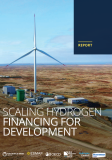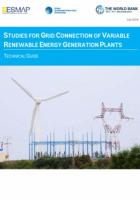Publications
This technical guide is the third in a series of four technical guides on variable renewable energy (VRE) grid integration produced by the Energy Sector Management Assistance Program (ESMAP) of the World Bank and the Global Sustainable Electricity Partnership (GSEP). It provides guidance on how to approach power system studies, which are required to ensure the stable interconnection of utility-scale VRE plants into the grid.
The report, which focuses on the transmission grid, identifies the steps the grid operator and the VRE resource entity need to follow to integrate these resources safely and effectively. It shows how power system studies verify that adequate reserves and system resources exist or what additional measures are required to reliably serve demand under credible contingencies, such as the loss of a generating unit, a transformer, or a transmission facility. The requirements for integration are elaborated in Technical Guide 1 (Grid Integration Requirements for Variable Renewable Energy).
Energy Sector Management Assistance Program. 2019. Studies for Grid Connection of VRE Generation Plants. ESMAP Technical Guide;. World Bank, Washington, DC. © World Bank. License: CC BY 3.0 IGO. https://openknowledge.worldbank.org/handle/10986/32073




